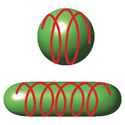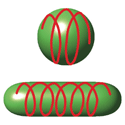Balancing forces in a petri dish
In times of plenty, bacteria follow a cycle of feeding, growing, and dividing. Holding the shape of bacteria in place as they grow is a layer of peptidoglycan—glycan strands cross-linked by peptides—that envelopes the cell wall. (The disruption of peptidoglycan production is the main effect of penicillin in fighting bacterial infections.)
An interesting feature of many rod-shaped bacteria is that new peptidoglycan, which is produced at the interior of the cell, mainly travels to the sidewalls, so the bacteria grow along their length and not at their ends. Writing in Physical Review Letters, Hongyuan Jiang and Sean Sun at The Johns Hopkins University, US, consider how the balance between chemical and elastic energy could explain the morphology of rod-shaped bacteria.
Jiang and Sun model the bacteria wall as an elastic balloon that is stretched using the chemical energy stored in a “patch” of newly arrived peptidoglycan. They show that a balance of these forces limits the radius of a rodlike bacteria’s poles (ends) but allows the cell’s length to grow linearly in time.
Though Jiang and Sun’s model neglects more complex features of the cell wall’s structure, their simple result may serve as a useful guideline for predicting the dynamics of cell growth. – Jessica Thomas





